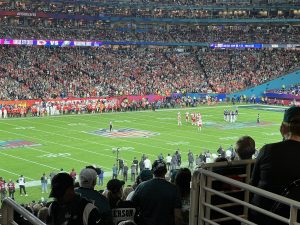- Slug: Eagles Almost in Phoenix. 910 words.
- Photo available.
By Brevan Branscum
Cronkite News
PHOENIX – Last December, executives from Tempe-based semiconductor company Amkor Technology won the NFL’s approval to acquire a 3.25% stake in the Philadelphia Eagles.
Eagles owner Jeffrey Lurie sold the minority stake to Susan Kim, chairman of the board of Amkor. As the Eagles head off to play in Super Bowl 59 in New Orleans, 3.25% of the team’s ownership now resides in Arizona.
However, 41 years ago, the entire Eagles franchise was on the verge of calling the Valley home.
In a forgotten moment in NFL history, former Eagles owner Leonard Tose agreed to sell 25% of the team for $40 million to Canadian real estate developer James Monahan. The deal came on the promise that the franchise would relocate to Phoenix, where the Eagles would play in Sun Devil Stadium beginning with the 1985 season.
The reason this history is forgotten? Former Arizona Republic columnist Bob Hurt, who broke the story and unintentionally saved the franchise from moving to Phoenix.
“Hurt’s column, all the details on what was going to happen, he put in his column,” said Ed Wisneski, the Director of Communications for the Eagles at the time. “That’s when people in Philadelphia, the mayor, and everyone else first found out about it.”
Wisneski, who also found out about the news the day after the story broke, added that the Tose and Monahan were flying directly to Phoenix following the final game of the 1984 season in Atlanta.
“It’s hard to speculate whether anything would have broken if Hurt had not written,” Wisneski said. “There had been arrangements made, at least from what I read, that the owners were going to fly to Phoenix rather than back to Philadelphia.”
The agreement was practically finished and the Eagles were following in the footsteps of the Baltimore Colts, who moved to Indianapolis the year prior in 1983. The Arizona State University Board of Regents was already conducting meetings to discuss a lease for the Eagles at Sun Devil Stadium. However, the city wasn’t going to watch the team leave without a fight.
After Hurt received word about the Eagles sale and broke the news, the city of Philadelphia was “turned upside down” for the rest of the week trying to figure out a way to prevent the deal from going through, according to Philadelphia sports columnist Ray Didinger.
The city also got help from the NFL, who worked with Tose and his daughter, Susan Fletcher, to keep the franchise in one of the nation’s biggest markets.
“The City Hall got mobilized. The NFL got mobilized. The fans literally circled the stadium,” Didinger said. “There was no way that the Eagles were going to get out of town and it was just a matter of working out how they were going to work this through.”
The city made financial concessions to persuade Tose to keep the team in Philadelphia, including building luxury boxes in the stadium and a new indoor practice facility. He agreed and the deal fell through, leaving Phoenix without an NFL team.
Hurt’s former Arizona Republic colleague, Kent Somers, said that Hurt, who passed away in 2009, seemed to know everyone and likely had multiple sources giving him information on the agreement and details.
“I remember going to a Final Four with him, and he ran into North Carolina coach Dean Smith on the street and he stopped to say hello,” said Somers, who covered the Cardinals and the NFL for years. “Writers in Philadelphia, when they found out it was Bob Hurt who broke the story, they’re like, ‘Oh, well then it’s true.’”
The team had already faced several significant financial struggles in the years leading up to the 1984 season, according to Philadelphia sports columnist Rich Hofmann. Former coach Dick Vermeil retired, a player strike in 1982 shortened the season and cost the team money, and home games stopped selling out due to lack of team success.
On top of it all, Tose was “gambling the franchise away,” creating a debt that ultimately led to his agreement to move the team.
“(Tose)] was a guy who spent first and asked questions later in everything he did in his life, including running a franchise, but he also very clearly had a gambling problem,” said Hofmann, who was with the Philadelphia Daily News at the time. “He had an Eagles employee as a part of his entourage who walked around with a gym bag filled with $25,000 cash in case he ran into the blackjack table.”
Tose sold the franchise for $65 million in 1985 to automobile dealers Norman Braman and Ed Leibowitz, who later sold to the current owner, Lurie, in 1994. 31 years later, Lurie has sold a small portion of the franchise back to the Valley.
While the former owner is infamous for nearly moving one of the premier franchises in the nation, Hurt, ironically, is cherished among longtime Philadelphia sports fans.
Hurt joked that he wanted a statue of himself built next to the “Rocky” statue outside the Philadelphia Museum of Art, according to Somers. His news didn’t cost Arizona’s chance at an NFL team for long, as the Cardinals moved from St. Louis in 1988.
As both cities and franchises went their separate ways, the “Phoenix Eagles” are simply a forgotten “what if”’ lost in NFL history.
“It’s hard to imagine an NFL where the Eagles aren’t in Philadelphia,” Somers said. “The Phoenix Eagles? The Arizona Eagles? It doesn’t exactly roll off the tongue.”
For more stories from Cronkite News, visit cronkitenews.azpbs.org.
